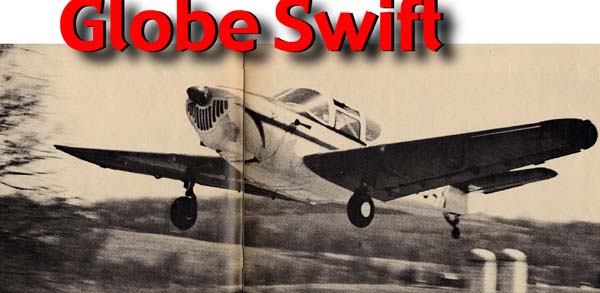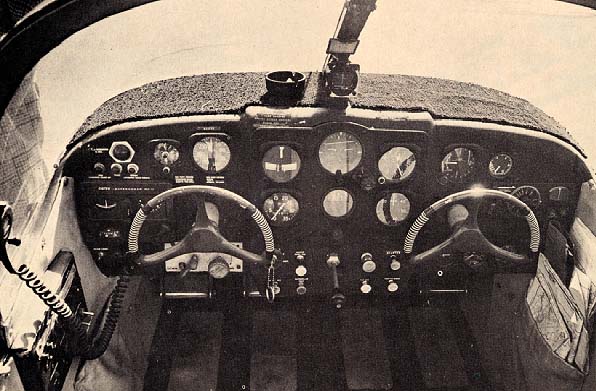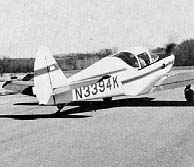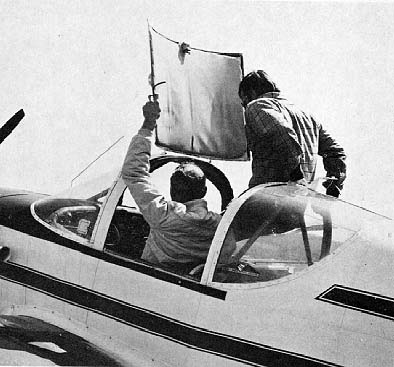

Editor's Note: This is the very first pilot report I ever did. Prior to this piece, I had published no more than possibly five articles and none were flight evaluations. At this point, I had been out of college barely a year and had less than 2,000 hours flying time. As of January, 2001, the total number of articles is well over 2,000, of which about 500 have been pireps. Just thought you'd like to know.
The Swift stands there like a bantam-weight boxer, gear wide apart, jaunty, blunt chin stuck out, ready to take on any and all comers, especially those who plan to smear its name with hastily prepared hangar tales.
"Easiest ground-looping airplane flying." "Get the wind in the gear wells on takeoff and you can taxi to Cleveland before you get off." "Vicious stall, breaks hard and will drop a wing fast." "Got a sink rate like a Greyhound bus." You've heard them all, but how often was the speaker a Swift pilot?
The armchair pilots delight in telling and retelling stories about almost every airplane, making each tale bigger and better to thrill the kids listening through the fence. As an airplane design gets older and there are fewer of the craft around, the tales multiply like guppies until the average pilot is afraid to even be near the runway when one of the dreaded designs comes in for a landing (which must surely end in a flaming ground-loop).
The Swift, unfortunately, is one of those airplanes. Every time one lands or takes off, at least one wizard is heard to remark how lucky the pilot was to make it.
Only one thing about the Swift is a confirmed fact---it is a pretty, little airplane, and that's what finally forced me to find out just how many of those aeronautical old wives' tales were true. I'd admired the Swift for years, and it didn't seem possible that anything so beautiful could be such a killer. I finally decided it was time to satisfy my curiosity or go back to watching goldfish reproduce.
I'd read lots of pilot reports on Swifts, but it was always so-and-so's superclean, supermodified, hyper-expensive, Merlin-powered job. I seemed to be the only one who cared how the average run-of-the-airport, dog-eared version flew. So I kept my eye open and finally found a nearly stock GC-1B 125 Swift, and conned its owner-Don Hazelton of Kinnelon, New Jersey-into taking me up and showing me what it's like to fly one of the phantoms of the runway.

Hazelton is a fairly quiet, unassuming type, and didn't strike me at all as being one of the superpilots I'd read about in Blackhawk comic books. As a matter of fact, he was a bit disconcerted when Air Progress's hawk-sharp associate editor, Donald Typond, and I cornered him. His one distinguishing characteristic is that he's 6 feet 3 inches tall, which not only made me feel like a midget but made his airplane look as if it came out of a box marked Revell.
November 3394K turned out to be a good choice. She was neither a dog nor a creampuff, just the average 1946 Globe Swift, the type that one sees advertised for $3,500 in every issue of the jaundice-yellow Sears catalogue of aviation, Trade-A-Plane. Her soft aluminum wing tips were shaped by 23 years of eager hands pushing and shoving, until, like Swifts everywhere, they were bruised and dented. The paint was new, but the wing walks were worn and torn--23 years is a lot of walking!
The interior is just like the rest of the ship--no Horton and Horton threads, just purely functional.
The walk-around inspection is similar to that for any other airplane, with special attention to items unique to the Swift. The complete top section of the cowling opens to check the oil in the 125-hp Continental, and is secured by two rather large handles reminiscent of 1949 Plymouth door handles, and the '49 Plymouth was not noted for streamlining.
Special attention is paid to the landing gear and emergency extension system. The early Swift gears used an oil/air oleo, but N3394K, like most Swifts, has been modified to the Adel oil/spring unit. Normally the gear is operated by an electrically actuated hydraulic system, but is backed up by a cable-operated system tied into a crank between the seats. The cable runs through the gear-well, in front of the spar. Hazelton was careful to be sure it hadn't gotten off one of the pulleys. The lowest point on a Swift is the middle of the center section, so a gear-up landing will leave a wound a bandage won't help.
 The gear is wide,
about 30 percent of the span (the same as a Cherokee's, for comparison),
but the tail follows the spinner quite closely, and the tailwheel
is about the size of a roller-skate wheel. Fortunately, the disc
brakes can take a lot of abuse, as they have to provide the steering
that the rudder and tailwheel can't.
The gear is wide,
about 30 percent of the span (the same as a Cherokee's, for comparison),
but the tail follows the spinner quite closely, and the tailwheel
is about the size of a roller-skate wheel. Fortunately, the disc
brakes can take a lot of abuse, as they have to provide the steering
that the rudder and tailwheel can't.
The Swift was designed and built before the fine art of stressed skin construction was fully developed. There were a number of factors that the engineers weren't too sure about, so when in doubt, they just made everything a little heavier and tossed in a few more rivets. For this reason, the Swift was a little on the heavy side for the engines then available. For the same reason, it's built like the proverbial tank.
Although the basic design is very clean, the execution of same is not. The tires extend into the slipstream, and there are numerous handles, latches, and gaps that combine to produce quite a bit of drag. Also, on this particular Swift, there is an L-shaped piece of rod affixed to each gear door, extending forward, and visible from the cockpit when the gear is down. That little jewel is easily worth three miles per hour.
While checking the gas, you've got to remember that there is a 14-gallon tank in each wing, but only one filler, in the left center section. The right tank, and the nine-gallon auxiliary under the seat, are filled by a cross-over pipe from the left side.
Airplanes that are pleasing to the eye are also usually hard to get into, and the Swift is no exception. The side windows push down and the top section hinges forward, but getting into the seat without stepping on it requires either longer legs than mine, or a lot more agility. It's very much like boarding a rowboat from the dock and trying to be graceful about it. Women may as well forget about being ladylike.
Once inside, the cabin fits like a sports car and is spacious enough to be quite comfortable and still not present a barn-door frontal area. The seats are not adjustable, so seating is changed via the old stack-a-cushion routine.
 I'm average in height,
and visibility straight ahead was limited, but by straining just
a little, I could see over the nose. While sitting in my usual
slumped position, visibility .was fine for all ground operations,
although a tricycle-gear driver might have a little trouble at
first. Of course, the notion that you have to see over the nose
is a fairly recent one, anyway.
I'm average in height,
and visibility straight ahead was limited, but by straining just
a little, I could see over the nose. While sitting in my usual
slumped position, visibility .was fine for all ground operations,
although a tricycle-gear driver might have a little trouble at
first. Of course, the notion that you have to see over the nose
is a fairly recent one, anyway.
Prior to starting, the fuel pressure was built up with the hand pump under the left seat. After that, starting procedure was normal.
The steering to the tailwheel is fairly direct, and not nearly as much brake was needed during taxiing as I had anticipated. Hazelton is careful to avoid graveled and rough areas be-cause of potential prop damage and dinging-up the ground-hugging belly.
I don't know what I had expected, but pre-takeoff preparation was simple and quite straightforward. The panel layout delayed things for a moment or two, as it was definitely not the usual basic-T layout. The design follows accepted procedure of the times and all flight instruments are grouped in a shock-mounted unit in the middle of the panel, with the rest of the instruments scattered wherever there is space. Rather than being a T, it resembles a Q.
When we lined up for takeoff I didn't know whether to say a Hail Mary, or to get out and walk. If even half of the stories I'd heard were true, the crosswind and the torque would make our takeoff path look like a corkscrew.
Because of the short fuselage and relatively tiny rudder, the application of power has to be slow and smooth to prevent any instantaneous buildup of torque. On this particular day, the wind was just a little off to our left at about 10 knots, but we experienced absolutely no unusual problems on takeoff. Hazelton will admit, though, that he would prefer not to fly on days when there is a strong left cross-wind. Landings aren't the problem-he says he could run out of right rudder on takeoff, if the wind is strong enough.
This part of the hangar tales appears to be true: In certain instances the stock Swift rudder is just not very effective. One of the most popular modifications is the Corbin rudder, and now I can see why.
The tail comes up by itself, and the little ship accelerates rapidly to the point that she will fly herself off at about 70 mph indicated. Under normal wind conditions, the takeoff roll required practically no footwork, and while it appears on the long side to spectators, it picks up speed so quickly that you're airborne in no time.
To anyone used to the trim electric switch in most contemporary gear-retraction systems, the Swift's gear switch is going to be a real shocker. It isn't a switch, it's a spigot that looks like a retread from an oil burner. It incorporates a rudimentary safety down lock, which must be de-pressed to move it, and is perched on its own little panel next to an equally archaic flap switch.
 There is very little
trim change noticed when the gear comes up, which is a good thing,
because you have to be double-jointed to reach the trim control.
It's as if the builders were trying to save money on trim cable,
or added it as an afterthought, but it's probably the worst trim
location on any airplane flying. It's not in the ceiling, not
on the floor, not even under the panel. It's mounted between the
occupants' heads and about a foot behind them. To make matters
worse, it's one of those horizontal crank abortions, and I noticed
even Hazelton turned around to look at it when he trimmed.
There is very little
trim change noticed when the gear comes up, which is a good thing,
because you have to be double-jointed to reach the trim control.
It's as if the builders were trying to save money on trim cable,
or added it as an afterthought, but it's probably the worst trim
location on any airplane flying. It's not in the ceiling, not
on the floor, not even under the panel. It's mounted between the
occupants' heads and about a foot behind them. To make matters
worse, it's one of those horizontal crank abortions, and I noticed
even Hazelton turned around to look at it when he trimmed.
Climb-out was at 80 to 85 mph and 2450 rpm. The vertical speed indicator showed an average of 700 fpm, which appeared about right. It's not exactly a P-51. Don told me his prop is somewhere between the climb prop and the cruise, so this could account for some lost climbing performance.
After reaching altitude, I began to kick it around a bit to feel it out. When describing flight characteristics, one has to remember that everything is relative. What is a light control feel to me might be heavy to a Pitts pilot, or overly sensitive to a dirigible jockey. A handy norm would be the old standard, the Piper Cherokee 140.
The first thing I noticed after leveling off was that my vertical flight path looked as if I were taxiing over plowed ground. The elevator forces are light and very responsive, as compared to the Cherokee, but they take very little getting used to.
The ailerons are also very responsive, but not as light as the elevator. The roll characteristics are such a joy that it is easy to see why many owners modify Swifts for aerobatics.
The rudder forces are light, but not terribly responsive. The pedals move easily, but a fairly large amount of movement is required to effect any changes. This is undoubtedly the result of the handkerchief-sized rudder.
The handling is such a change from the usual pick-up truck feel of most American designs, that you find yourself playing fighter pilot and racking it around in 90-degree banks and screaming chandelles. The only bad feature in flying the airplane is the shape of the control wheel itself. I never did find a comfortable position for my hand.
 The Swift's stall
has long been a subject for lawn-chair aviators to banter around.
I investigated the stall characteristics, both gear down and clean,
and could find nothing that I would consider particularly dangerous.
We've become so accustomed to a sinking, mushy stall that anything
else is considered a threat to humanity. The Swift does have a
clean stall: It flies right up to the breaking point, buffets
about twice, and then drops its nose. It doesn't drop like a rock,
nor does it fail to give warning and then plant your scalp on
the cabin roof. The stall is sharp, but normal stall recovery
is more than sufficient to get it flying again. The slots in the
out-board wing panels seem to contribute significantly to aileron
control while stalled, and might have something to do with the
clean breaking feature.
The Swift's stall
has long been a subject for lawn-chair aviators to banter around.
I investigated the stall characteristics, both gear down and clean,
and could find nothing that I would consider particularly dangerous.
We've become so accustomed to a sinking, mushy stall that anything
else is considered a threat to humanity. The Swift does have a
clean stall: It flies right up to the breaking point, buffets
about twice, and then drops its nose. It doesn't drop like a rock,
nor does it fail to give warning and then plant your scalp on
the cabin roof. The stall is sharp, but normal stall recovery
is more than sufficient to get it flying again. The slots in the
out-board wing panels seem to contribute significantly to aileron
control while stalled, and might have something to do with the
clean breaking feature.
I attempted to get N3394K to demonstrate the Swift's famous tendency to tuck under when stalled in a turn, but it never did. The plane rolled left in both right and left turning stalls, so I'm sure it was a question of rigging. As long as the ball was centered, the stall was normal, and I was racking it around fairly hard.
Even a slightly cross-controlled stall produced only a gentle roll, instead of the much advertised spin/spiral combination; another hangar tale shot down.
I did notice that as the nose came up and the airspeed fell off, the rudder lost effectiveness-nothing dangerous, but something worth remembering while landing.
"How fast'll she go, mister?" It's the first question everybody asks, and one of the things I was determined to find out about the "average" Swift. Not wanting to trust airspeed indicators and computers, we decided to make two-way runs over an easily measured course and use the average. Don flew and held his usual cruise setting of 2350 rpm. We indicated 110 mph, and while Don concentrated on holding altitude, I watched my sweep second hand. When all was said and done, we ended up with a solid 127 mph. Not exactly blinding, but good for 125 hp.
The handbook calls for a cruise of 140 mph, but the difference is easy enough to explain. Having the correct prop for cruise would make some difference, but the majority of the lost miles per hour have been stolen away by 23 years of hard riding. The high wind noise in the cabin could be traced to numerous gasket, window seal, and other miscellaneous leaks-all of which contribute to drag, and all of which steal speed. Also, I could see that curious gear position indicator poking up over the leading edge of the wing, vibrating like mad.
 Letting down to enter
the pattern, I investigated the sink rate. At 75 mph, gear and
flaps down, the VSI showed about 800 fpm-fast, but no worse than
a loaded Cherokee or Tri-Pacer. With 132 square feet of wing area,
the wing-loading works out to about 14 pounds/square foot, or
two pounds less than a Cherokee Arrow, and almost the same as
a Cherokee 140.
Letting down to enter
the pattern, I investigated the sink rate. At 75 mph, gear and
flaps down, the VSI showed about 800 fpm-fast, but no worse than
a loaded Cherokee or Tri-Pacer. With 132 square feet of wing area,
the wing-loading works out to about 14 pounds/square foot, or
two pounds less than a Cherokee Arrow, and almost the same as
a Cherokee 140.
Hazelton recommends a wheel landing whenever possible, mostly because of the almost nonexistent tail-wheel. Accordingly, we flew the approach with power, indicating 75 mph. The gear and flaps were dropped at about 90 mph, and it felt like a Cherokee 140 from there on out. The touchdown on the main gear was followed by application of a considerable amount of forward pressure. We decelerated rapidly and continued to hold a negative angle of attack until the tail dropped, the wheel was brought back, and the binders applied. Even though the conditions were gusty and washboard rough, the Swift rode right on through, and the roll-out didn't even come close to giving me gray hair.
Don says that, although he usually wheels it on, he has approached to a three-point landing as slow as 65 mph, and reports that the landing roll is drastically reduced. I could see where a three-pointer in a high, or gusty, crosswind could lead to high-speed cardiac arrest, but this is true in any taildragger.
All in all, the Swift 125 is a delightful little package to kick around upstairs. It's really a shame that it has been so slandered, because it just doesn't deserve to be picked on. The old 85-hp models may have been all the tales say, but not the 125, and the 150- to 220-hp modifications should be fantastic.
Although space limits baggage to a toothbrush and half a tube of tooth-paste, and it's not terribly fast (unless cleaned up), the Swift is a good cross-country machine for the money. You get retractable gear, economy, and more fun than a sack full of girls (well, almost). Your $3,500 buys you an all-metal, heavily built machine that just reeks of class; one that puts you among the aces in your friends' eyes.
Do you have to have beaucoup hours to handle the Swift? Not on your tintype! Don Hazelton bought his Swift when he had only 60 hours total time, and no tailwheel time at all!
That pretty well pokes holes in any stories you'll hear about the Swift. Have a competent instructor check you out, fly it like a Swift, and you won't get in trouble.